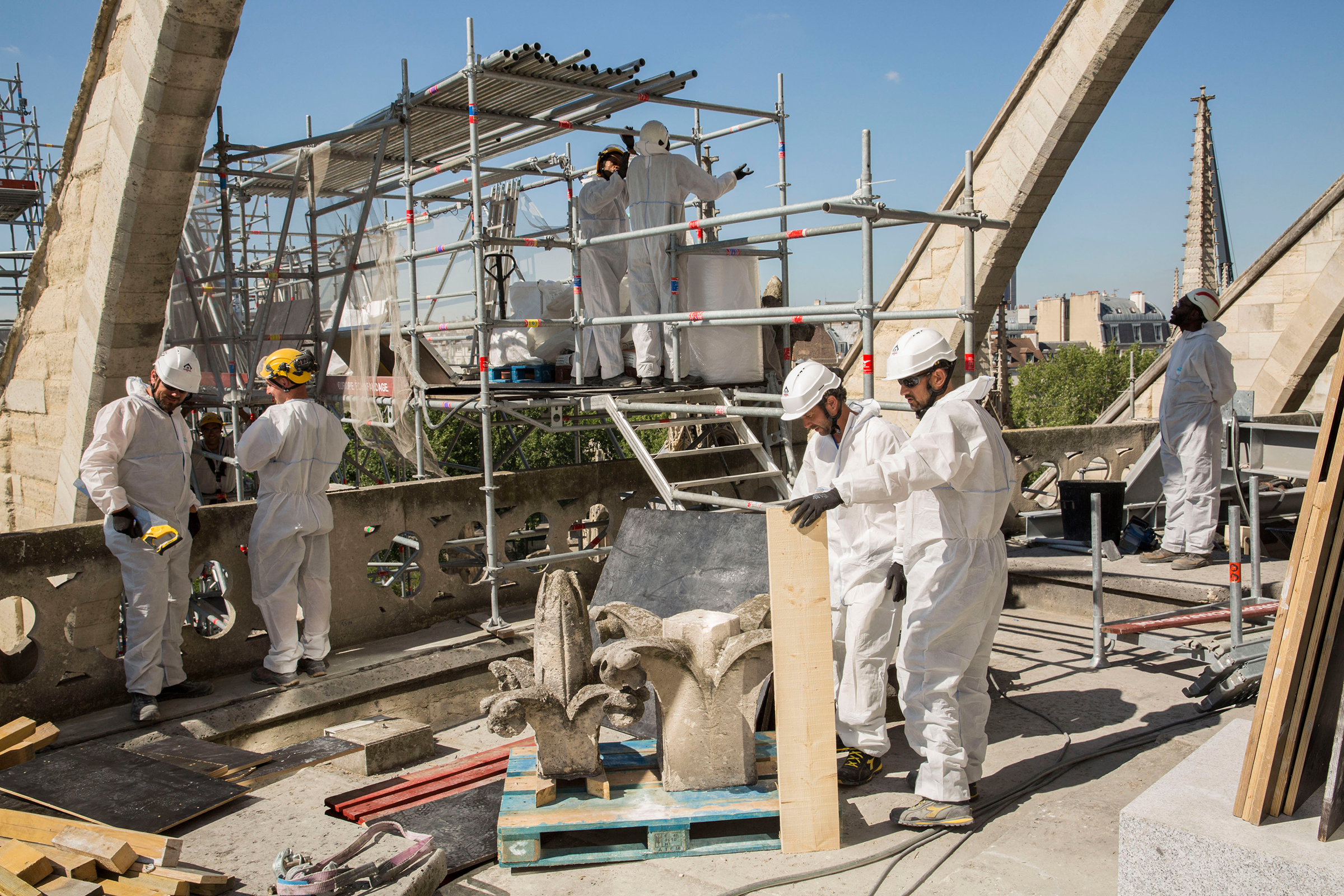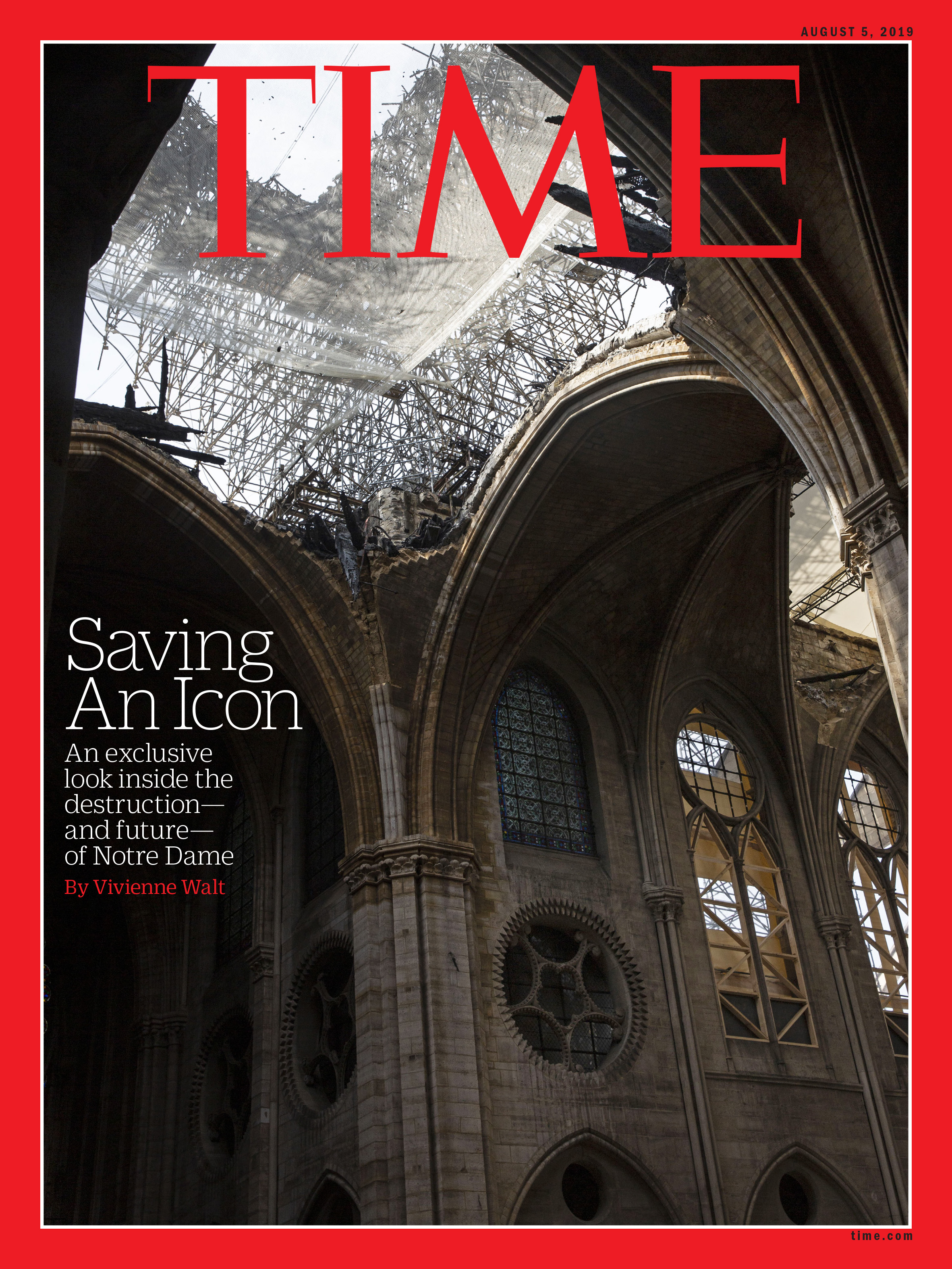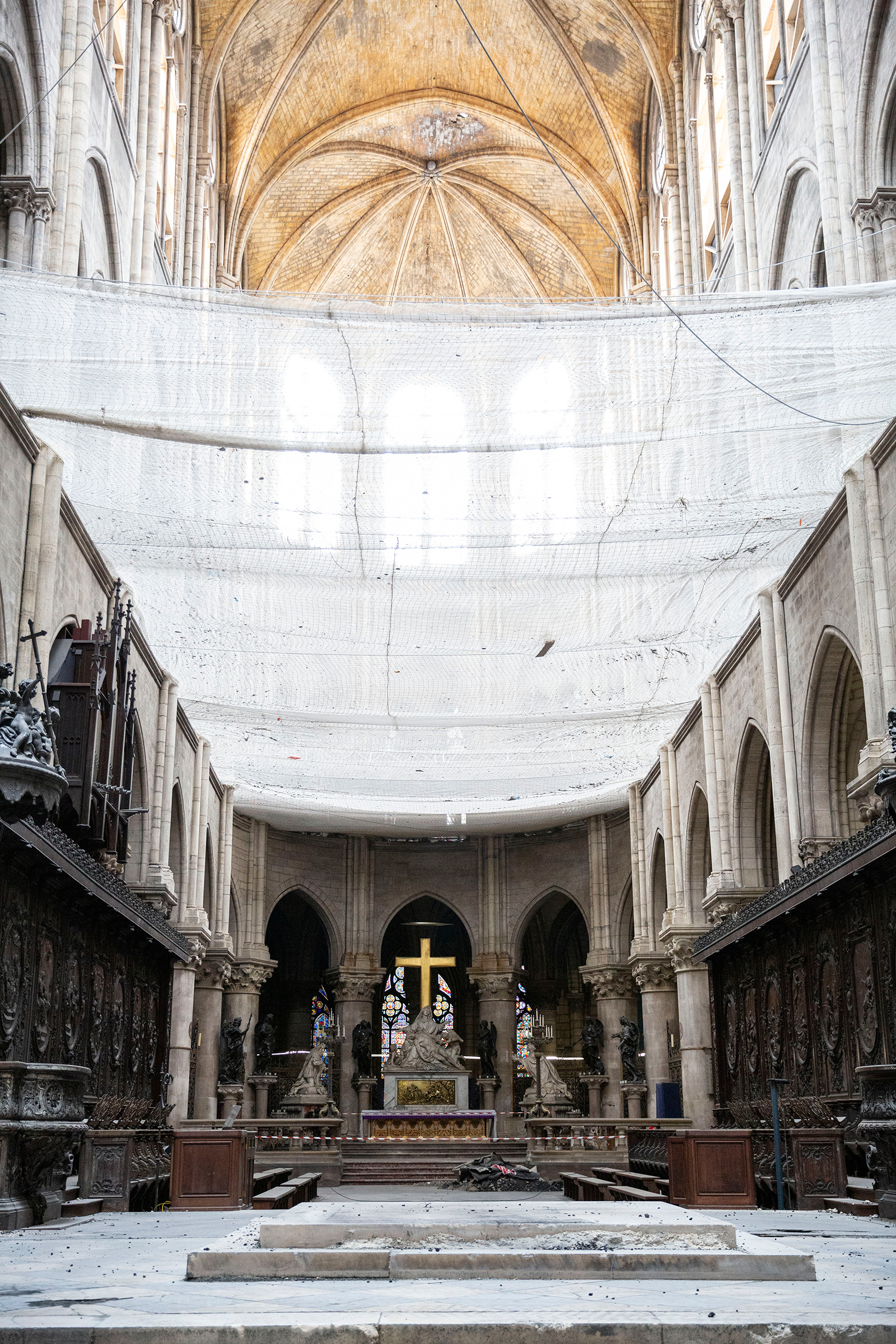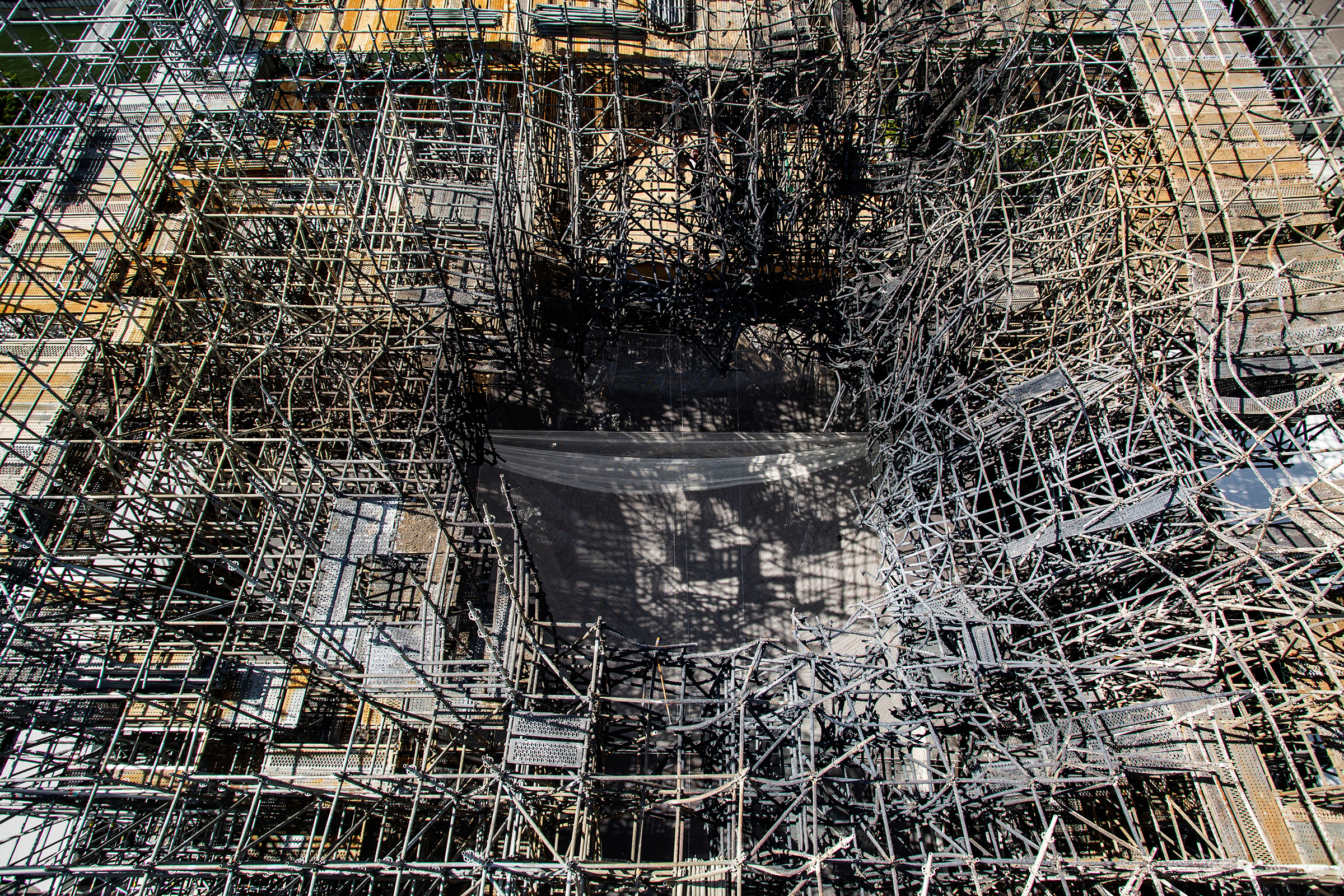
Stumbling through choking smoke, Antoine-Marie Préaut was on a divine mission. The conservator of the 4,000 or so historic monuments in the Paris region made his way through the burning Notre Dame cathedral on April 15 to rescue from a locked chest the Crown of Thorns that Jesus is said to have worn to his Crucifixion. The minutes were ticking by, and there was no certainty Préaut and the firefighters accompanying him would succeed in recovering the priceless relic. “I barely had any consciousness about what was happening,” he says. Then he heard a roar from the huge crowd that had gathered on the square outside the medieval masterpiece in the heart of Paris, and his heart sank. “We heard the cries of all Parisians outside,” he says. “We said to ourselves, ‘The spire must have fallen.’”
The cause of the blaze is still unknown, yet what it exposed is clear — the fragility of our most cherished buildings and the wistful attachment we hold to the spaces within their walls. The cathedral’s spire snapped off like a twig just before the sun set, crashing 314 ft. into the nave, through the ceiling that carpenters had painstakingly carved by hand in the Middle Ages, using 5,000 oak trees. Within France itself, the Notre Dame fire laid bare another, more complicated fragility: a tension rippling through the country, pitting the urge to preserve the past, and traditions of an exceedingly proud nation, against the need to overhaul its hidebound ways and modernize its system.

In early spring, the fractures in France were playing out in the most violent street demonstrations in decades, with the so-called Yellow Vest movement protesting President Emmanuel Macron’s plans to remake the country’s economic model. Enraged by an elite class — epitomized in their minds by Macron — that appeared to have no understanding of their financial pain, demonstrators marched, while agitators repeatedly trashed and burned stores and banks across the country.
Then came the Notre Dame fire. Amid the boarded-up and smashed storefronts across the city, the sight of smoke billowing from one of its most treasured icons seemed to deepen a sense of a country under strain. “There was a spirit of destruction which really collided with the spirit of maintenance and protecting our culture from the past,” says Nicole Bacharan, a French political analyst and author. “It was a moment people truly shared, that said something important about what it meant to be French. It was not a terrorist attack. It was not a natural disaster. It was a sudden violent destruction of something people hold very dear.”
The destruction of the cathedral seemed to many like a turning point. It was “the drop of water that made the vase overflow,” says Thierry Paul Valette, one of the Yellow Vest leaders in Paris. With the embers still smoldering inside Notre Dame and the French in collective grief over the fire, Macron went on television the next day to appeal for national unity and vowed to have Notre Dame rebuilt within five years. “I believe very deeply that we can transform this catastrophe into an occasion to come together,” he said. “Politics will take over again, but it is not the moment now.”
The appeal to unity seems to have worked, at least for now. The weekly protests have abated, with demonstrators exhausted from eight months of battle. But the place of worship that 14 million tourists a year once visited remains a shuttered wreck on Paris’ Île de la Cité, and now the old divisions are beginning to gather around what comes next for the beloved building. The fraught discussion cuts to France’s most sensitive matters of history and culture, class and political ideology, with questions that will likely take months to resolve. How quickly can it be rebuilt, and what will it look like when it is? What will it cost, and who will pay? And there is another question that has bubbled quietly ever since the fire ignited atop the roof: Did official penny pinching, and the labyrinthine structure of the French state, unwittingly lead to disaster?
In the meantime, the Gothic jewel remains behind police barricades, a magnet for crowds of gawkers who gather to watch the salvage work, like rubberneckers at a road accident. “As Notre Dame burns, so falls France,” the French writer Sébastien Lapaque mused in Le Point magazine in June. The cathedral sits at the zero point of all the country’s map readings, Lapaque tells us, and is a fitting representation of the country’s troubled state at the moment. “It has a double symbol, both politically and spiritually,” he says.

Stepping inside Notre Dame today is like entering a mausoleum. In sharp contrast to the cathedral’s typically crowded nave, where tourists and worshippers jostle for space, the huge interior is eerily empty and silent, the only movement coming from remote-controlled construction vehicles; it is still deemed too risky to have humans disturb the fire-damaged space. The robot earthmovers, dwarfed by the towering vault, edge slowly in and out of the nave, extracting the fallen stonework and burnt wood, piece by piece — including bits of the shattered spire — that crashed through the roof during the fire and now sit in a pile of debris. Each piece is meticulously cataloged, then placed in a tent in Notre Dame’s front yard, in readiness for restoration.
Where the oak roof frame known as the “forest” once was, there is now a giant cavity open to the sky. The fire incinerated the entire roof, as well as its latticed wooden interior and the spire. Three of the stone arcs of the ceiling, some of them dating from the 13th century, also collapsed in the fire. Lengths of plastic sheeting and nets now shelter parts of the cathedral from rain, dust and in June a severe heat wave that accelerated the damage to the stonework. To reach the rooftop site where the fire began, we climbed the 300 narrow, spiral stone steps in early July, then up a makeshift stepladder with a rope-hold. Months on, the levels of lead in the air are still dangerously high, and we were obliged to don disposable overalls in the cathedral and advised to launder all clothing when we left.
At least until the end of the year, this will be a triage site, as workers scramble to preserve the fragile ruins of the building. From outside, the worst appears to be over, but inside, there are deep worries about the continuing risks to Notre Dame — including the lingering possibility that the cathedral could still collapse.
Sensors placed around the building the day after the fire show that its structural elements have not shifted during the months since, despite the severe shocks it suffered from the collapsing roof and spire, the falling stonework and the hours of high-pressure water that firefighters pumped into the building in their desperate fight to bring the blaze under control. Since Notre Dame is deemed still too fragile for humans to work directly on many of its surfaces, it will be months before the 100 or so construction workers, engineers and architects can assess the full extent of the damage from the fire.
The gravest risk is that the dozens of ancient stone vaults, or arcs, that crisscross the vaulted ceiling could still fall. In the worst-case scenario, that could cause Notre Dame’s 28 flying buttresses — an invention of Gothic architecture — to collapse inward on the walls and bring down the building. “Considering all the vaults took — with the fire, the water, the shocks, the roof framing that collapsed on them — we do not know if there are fissures and fractures,” says Philippe Villeneuve, Notre Dame’s chief architect, who is tasked with overseeing the reconstruction. Standing atop the roof, he says, “We do not know because we cannot go and see them.”
To prevent such a disaster, in early July a giant crane began hoisting 7-ton wooden frames cut to the exact specifications of the flying buttresses, to be wedged inside each arc, in order to weigh them down and stop the building from shifting. Once all 28 frames are fixed — expected to be in August — workers will construct walkways on the roof so they can begin examining each surface close up, in search of damage that might have been overlooked.
The realization that Notre Dame came close to collapsing on the night of April 15 — and the prospect that it might still face an existential threat — haunts those now working to rebuild it. For many, the work is deeply personal. André Finot, 37, Notre Dame’s communications chief, was a priest’s assistant when he was 15 years old. “It is very, very much a part of me,” he says. Villeneuve, 56, says he began dreaming of being Notre Dame’s architect as a small boy, when he came across his grandfather’s books on what he calls “my cathedral.” Since the fire, he says, he has struggled to sleep and has consulted a therapist. “I have been wounded and wrecked, truly crushed with pain,” he says. “There are tears that have not yet even come.”

Before the fire was even extinguished on April 15, donations and pledges of help to restore the cathedral began pouring in. Donors big and small have since promised around €850 million ($950 million) to fund the restoration, much of it within days of the disaster. The irony is not lost on Notre Dame’s staff and supporters, who for years had struggled to raise money for even urgent repairs. In the two years before the fire, the charity Friends of Notre Dame raised $4 million to pay for pressing work, including a four-year restoration of the now destroyed spire. In just the three months after, the U.S.-registered charity has raised more than $8 million.
If the cathedral had a fully funded restoration program, some believe, the calamitous fire might have been averted. “If we had permanently restored the cathedral in the past 150 years, certainly we would not have been in this position,” says Michel Picaud, head of Friends of Notre Dame. “We had looked for resources to restore it before the fire, and we had struggled to do so.” This willingness to allow the cathedral to decay has echoes in history; the cathedral’s last major restoration occurred in the 19th century, only after Victor Hugo described its parlous state in The Hunchback of Notre Dame. Villeneuve says he had long ago drafted plans for Notre Dame’s needed repairs. “They only had to press a button, and we would make them,” he says. “We just did not have the money.”
The fire exposed what had long been known inside Notre Dame; the French government allotted only about €2 million a year for its upkeep. Paris’ best-known place of worship fared better than many other sites; among France’s 87 cathedrals, it was the only one with a security guard on duty, according to Préaut, the conservator of Paris’ historic sites. But the city’s firefighters were only alerted to the blaze on April 15 a full half hour after it began whipping through the upper level — after the lone security guard finally climbed the 300 stone steps to the roof and saw the inferno raging out of control. “It was too late,” Finot says.
Now Notre Dame’s needs are of a different order of magnitude. Once the building has been secured sometime next year, an entire roof, ceiling and spire will need to be built from scratch. Each inch of the vast cathedral needs to be cleaned of lead, about 300 tons of which fell from the roof. Of the money pledged, the bulk has been promised by French billionaires, including €200 million from the family of Bernard Arnault, the world’s second richest person, and its luxury-goods group LVMH; €200 million from the Bettencourt-Meyers family and its cosmetics giant L’Oréal; and an additional €100 million from billionaire François Pinault. Apple, Disney and IBM are among the companies that have also pledged to help.
But only small fractions of these huge sums have been paid so far. The Arnault and Pinault families had each paid €10 million by late June and are awaiting formal contracts with France’s Ministry of Culture, due on July 29, before transferring more money, according to Christophe Rousselot, managing director of the Foundation of Notre Dame, an organization founded in 1992 by the Catholic Archdiocese of Paris, which is now coordinating those funds.
Until late June, the work under way at Notre Dame — the urgent cleanup operation and the critical task of stabilizing the building — was being funded largely by small donors, ordinary folks in France and elsewhere who logged on to fundraising sites during the first hours after the fire.
“There is nothing that compares to this,” says Celia Verot, director general of France’s Heritage Foundation, a semiprivate organization that funds restoration projects for the country’s 40,000 or so listed heritage sites. Her group has so far received about €55 million in donations from 230,000 people in 152 countries, she says, roughly one-fourth of the total pledged. Rousselot says his group is collecting about €200,000 ($223,600) a week, despite the fact that it has barely appealed for funds since the fire. “The donations have been completely spontaneous,” Rousselot says. “With a natural disaster, people donate because they see appeals. But with Notre Dame, it is a completely different case, because of the attachment of the French and people around the world. It is about personal memory, history, family.” Although donations have come from around the world, Verot and Rousselot say much is from the French themselves — in a country, they point out, where philanthropy is not commonplace and is only partly tax-deductible. “They saw their cathedral burning and were very sad,” Verot says. “The act of giving makes them happy.”
Yet the seemingly effortless flood of money for Notre Dame has angered many people here, especially those who have taken to the streets in recent months against ostentatiously wealthy elites. “People were shocked that it seemed so easy to give €100 million,” says Bacharan, the political analyst, who has written extensively on comparisons between the U.S. and France. Among the Yellow Vest protesters, there is a sense of injustice that Notre Dame’s fire has brought huge generosity, while their own financial struggles have not. “People are asking for money for purchasing power, and then billionaires give millions and millions,” says Valette, the Yellow Vest leader, who says he was deeply sad about Notre Dame’s fire. “For stone, we give a lot of money. For people who are hungry, we give almost nothing.”

By the time the hundreds of millions of euros finally begin to flow for Notre Dame’s reconstruction, the moment of political comity over the building will likely have truly vanished. Even shortly after the fire, critics on the far left were accusing the President of exploiting the fire for political ends. “With Notre Dame, Macron sees a chance to burnish his image,” the left-wing news site Mediapart said on April 19. “It is as if months of raging anger on the streets were suddenly only a distant rumor.”
The President’s foes on the right echo this criticism, pointing to Macron’s five-year deadline for the rebuilding, a period that would encompass the presidential elections in 2022 and end just before the Summer Olympics in Paris in 2024. “He did this to correspond exactly to his re-election,” says Jacques Grosperrin, a member of the French Senate from the right-of-center Républicains party.
But the most contentious fight is yet to come, over what kind of cathedral should emerge from the fire. That question is already pitting Macron — the technophile leader who called for an “inventive reconstruction” of the cathedral — against the conservatives, who cast the French leader as an arriviste with no great respect for tradition.
Two days after the fire, Macron’s close ally Prime Minister Édouard Philippe announced an international architecture competition for Notre Dame. Some of the world’s top architects unveiled designs to replace the vanished roof, especially the shattered 295-ft. wooden spire, which was added to Notre Dame only about 150 years ago by the 19th century French architect Eugène Viollet-le-Duc. The British architect Norman Foster, who put a glass dome on Berlin’s Reichstag in 1999, called for a “modern, fireproof, lightweight” roof. French-American architect Cooper Copetas, born and raised in Paris, proposed a spire made of steel and glass bricks that would cast a beam of diffused light into the nave.
Now at SB Architects in Miami, the 26-year-old tells us he grew up passing Notre Dame frequently and was devastated watching the fire from the U.S., before seeing it as an opportunity to design something fresh for his hometown. Paris, he says, has rebuilt structures many times through the centuries. He believes that replicating an old design is “dishonest.” Instead, a contemporary touch “is something Notre Dame deserves,” he says. “It has lost something. So something made of frosted glass, that is ambiguous from afar, could represent the ghost of what used to be there.”
These kinds of proposals alarmed conservatives and traditionalists, and in May, the Républicains-dominated Senate held up an attempt to pass a law that will guide the reconstruction of the cathedral, disagreeing with the lower house, controlled by Macron’s La République en Marche, over how the spire should be rebuilt and when the deadline should be set. Yet the parliamentary debate was mainly symbolic; the cathedral has been owned by the French state since the French Revolution in 1789, which means theoretically Macron and the government get to decide how the reconstruction should proceed.
It’s still unknown. Despite Philippe’s announcement three months ago, the government has yet to set up a structure to receive designs, and it says a scientific committee will eventually consider the options. But veering from strictly traditional designs could provoke a major political battle. Macron’s critics on all sides accuse the President of trying to build his legacy around Notre Dame, much as former President François Mitterrand commissioned the intensely controversial glass pyramid by I.M. Pei at the Louvre Museum in the 1980s. “Macron wants to leave his imprint on Notre Dame. It is for the people of France to decide,” says Grosperrin, who favors holding a national referendum on the rebuilding. “We know we are a very fractured nation, with the Yellow Vests and the demos. But this is Notre Dame. It is our heritage, our history.”
A political fight might also have financial consequences. Verot says some donors have specified that their money is “not for contemporary architecture.” Rousselot says he too has found that big and small donors are averse to innovation. “In general, people do not want anything extraordinary or very different than what existed before April 15,” he says. “That is for certain.”
By luck, engineers have conducted 3-D scans of Notre Dame over the past 25 years, allowing those rebuilding the cathedral to follow the designs of centuries ago. Those toiling inside Notre Dame after the fire appear to favor this option, though they hasten to add that it is Macron’s decision, not theirs. “This is above all a place of worship,” says the cathedral’s chief architect, Villeneuve. “We do not do just anything on a monument like this.”
It will be months, if not years, before the debates over money and design are finally resolved — time that nonetheless is a blink of an eye compared with Notre Dame’s original construction nearly a millennium ago, when carpenters, architects and stonemasons spent two centuries creating a spectacular medieval temple. But for now, people in Paris are focusing not only on what was destroyed but also on what was saved — like the cathedral’s most valuable treasure, the Crown of Thorns. When Préaut finally made it through the thick smoke to the locked chest where it was kept, he held his breath. “We turned the key,” he says. “And it opened.” He helped carry the 2,000-year-old relic to safety, stumbled back out of the burning cathedral and joined the throngs of Parisians grieving for Notre Dame.
More Must-Reads From TIME
- The 100 Most Influential People of 2024
- The Revolution of Yulia Navalnaya
- 6 Compliments That Land Every Time
- What's the Deal With the Bitcoin Halving?
- If You're Dating Right Now , You're Brave: Column
- The AI That Could Heal a Divided Internet
- Fallout Is a Brilliant Model for the Future of Video Game Adaptations
- Want Weekly Recs on What to Watch, Read, and More? Sign Up for Worth Your Time
Contact us at letters@time.com